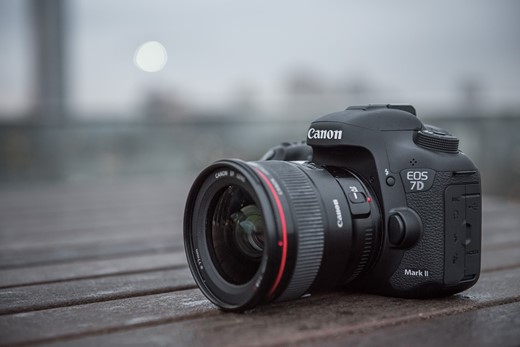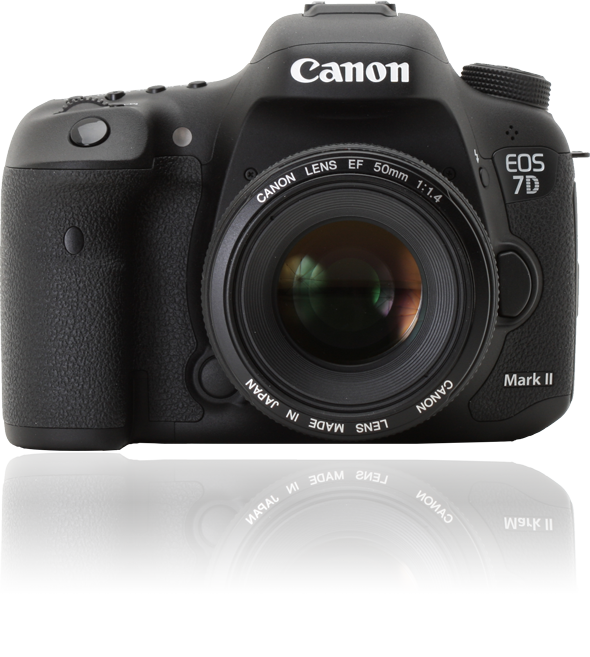Bài viết hiện tại: Canon EOS 7D Mark II Review
In the five years since its launch, the Canon EOS 7D has gone from being a cutting-edge piece of technology to an apparent remnant of a bygone age. Not simply in the sense that its technology has been superseded, but also in that the idea of a pro-grade APS-C DSLR seemed to one whose time had passed.
Canon clearly doesn’t think this is the case and, just as it did with the original 7D, has applied truly pro-grade autofocus to one of its best-built bodies. While Nikon appears to be encouraging its high-end users across to full frame, Canon’s range continues to offer a range of options. The long-awaited EOS 7D Mark II takes the strengths of its predecessor – highly capable autofocus and video – and builds on every aspect of them.
Canon EOS 7D Mark II key specifications:
- 20MP Dual-Pixel AF CMOS Sensor
- 10 fps continuous shooting with autofocus
- 65 all cross-type autofocus sensor
- 150,000 RGB + IR pixel metering sensor
- Dual Digic 6 processors
- Enhanced environmental sealing
- Compact Flash (UDMA) and SD (UHS-I) slots
- USB 3.0
- Built-in GPS
- Larger-capacity LP-E6N battery
- Shutter speeds up to 1/8000th seconds
- Shutter rated to 200,000 cycles (vs 150,000 on 7D)
For stills photographers, the EOS 7D Mark II offers an all cross-type, 65-point AF module. This works in conjunction with information from a 150,000-pixel RGB + IR metering sensor to offer the latest version of the ‘Intelligent Tracking and Recognition’ (iTR) focus system from the EOS-1D X. This means that with iTR engaged and an initial focus point selected, you can initiate focus with a half-depress of the shutter button and then allow the camera to track the subject as it moves across the frame. In this scenario, the camera automatically uses whichever AF point is necessary to maintain focus on the initially selected subject.
The camera’s continuous shooting rate jumps to 10 frames per second – something that was limited to pro-grade sports cameras until relatively recently. Along with this comes a shutter rated to survive 200,000 cycles.
The main image sensor is a variant of the Dual Pixel AF design first seen in the Canon EOS 70D, which means 20MP output. It also means the camera is able to capture information about both subject position and depth whenever its mirror is up, using its image sensor. This can potentially provide more decisive autofocus and subject tracking in ‘Live View’ and while shooting video. Speaking of movies – the 7D II’s movie capabilities get a bit of a boost – gaining 1080p/60 shooting capability and a second choice of wrapper (MOV or MP4) and a third compression option (IPB-Lite, as well as IPB and All-I).
Compared to EOS 7D/Nikon D7100
What a difference half a decade makes. The EOS 7D was one of the first DSLRs to offer 1080p video recording – a feature that’s now expected, even though it hasn’t necessarily been perfected. The Mark II’s Dual Pixel AF has the potential to offer impressive autofocus during video capture, since it’s able to assess subject position and distance from every captured frame. In principle, this could be enough to allow the 7D II to offer reliable autofocus during video – which would be a major selling point for keen videographers.
On the stills side of things, Canon has made remarkably few advances in sensor technology since the launch of the original 7D, and variants of its sensor still underpin much of the company’s lineup.
|
Canon EOS 7D II |
Canon EOS 7D |
Nikon D7100
Bài viết liên quan: Đánh giá LG V50 ThinQ – liệu đây có phải chiếc điện thoại bạn đang tìm kiếm? |
|
|---|---|---|---|
| Effective Pixels | • 20.2 MP | • 18.0 MP | • 24.1 MP |
| ISO Range | • 100-16000 standard • 25600 expanded |
• 100-6400 standard • 12800 expanded |
• 100-6400 standard • 50-25600 expanded |
| Movie options | • 1080p/60/50/30/25/24 • MP4 or MOV • All-I, IPB, IPB-Lite |
• 1080p • MP4 |
• 1080p • |
| No of AF points | • 65 (All cross type, center double-cross) | • 19 (All cross-type) | • 51 (15 cross-type) |
| Metering sensor-assisted AF tracking | • Yes | • No |
• Yes |
| AF in live view | • On-sensor phase detection | • Contrast detection | • Contrast detection |
| Spot-metering linked to AF point | • No | • No | • Yes |
| Maximum shutter speed | • 1/8000th sec | • 1/8000th sec | • 1/8000th sec |
| Flash Sync speed | • 1/250th sec | • 1/250th sec | • 1/250th sec |
| Screen | • 3.0″ 3:2 • 1,036,800 dots • (720 x 480 px, RGB) |
• 3.0″ 4:3 • 920,000 dots • (640 x 480 px, RGB) |
• 3.2″ 4:3 • 1,228,800 dots • (640 x 480 px, RGBW) |
| Viewfinder | • 100% coverage • 1.0x magnification • (0.63x in 35mm terms) |
• 100% coverage • 1.0x magnification • (0.63x in 35mm terms) |
• 100% coverage • 0.94x magnification • (0.63x in 35mm terms) |
| Continuous drive | • 10 fps | • 8 fps | • 6 fps |
| Buffer depth | • 1090 JPEG • 31 Raw |
• 130 JPEG • 25 Raw |
• 33 JPEG* • 9 Raw |
| Storage | • Compact flash • SD/SDHC/SDXC |
• Compact flash | • SD/SDHC/SDXC • 2 slots |
| Weight (inc batteries) |
• 910g (2.0 lb) | • 860g (1.9 lb) | • 765g (1.7 lb) |
| Dimensions | • 149 x 112 x 78 mm (5.9 x 4.4 x 3.1″) |
• 148 x 111 x 74 mm (5.8 x 4.4 x 2.9″) |
• 136 x 107 x 76 mm (5.4 x 4.2 x 3.0″) |
| GPS | • Built-in | • Optional | • Optional |
| Wi-Fi | • Optional | • Optional | • Optional |
* Figures are for 12-bit compressed Raw and Large/Fine JPEGs.
Updates to review:
Sept 15, 2014: Introduction, Specifications, Body and Design, Operations and Controls, and Autofocus pages published.
Oct. 23, 2014: Studio Test Scene added.
Nov. 21, 2014: Shooting Experience added.
Dec. 1, 2014: Lab Report (Studio Test Scene) analysis added based on a production camera.
Dec. 11, 2014: Review published. Added Performance, Exposure Latitude, Real World Raw DR, Video Features, Shooting Video, Studio Lab Report (video), Video Quality, and Conclusion pages.
Rumor has it Canon is planning to release a successor to its APS-C flagship EOS 7D Mark II in the first half of 2018. After 3 years, it’s probably due an upgrade – here’s our wishlist for a Mark III.
Nikon’s newest D7500 gains a lot from the D500 and loses a few things compared to its predecessor, the D7200 – but Canon’s got at least one model that looks pretty comparable. Let’s see how they stack up.
Canon has made the previous version, 1.1.0 available for download again.
Firmware version 1.1.1 for the EOS 7 Mark II includes various bug fixes and improves the reliability of communications when transferring images using the Wireless File Transmitter WFT-E7. Learn more
Canon has released the firmware update it promised for the EOS 7D Mark II when it launched the W-E1 ‘card-shaped’ wireless adapter. Read more
The Vivo X60 Pro+ claims to be a smartphone for ‘pro photography.’ While that’s up for debate, there’s no question this $1,200 device offers a lot of photographic power in a (relatively) small package.
We’ve been shooting with Nikon’s stylishly retro Z fc for the past few days, so let’s dig in to see what this 20MP APS-C Z-mount camera offers.
Sigma’s 35mm F1.4 DG DN Art is a designed-for-mirrorless reimagining of the company’s very first ‘Art’ lens that was released all the way back in 2012 for DSLR cameras. It’s got some big shoes to fill, so check out how it fares in our review.
Bài viết liên quan: Review và giải thích phim Us – Chúng ta (2019)
We’ve just completed our studio scene analysis of Sigma’s diminutive fp L high-resolution mirrorless camera – take a look at how its 61 megapixel sensor performs against other mirrorless options in both Raw and JPEG, at high and low ISO values.
There are so many Thunderbolt Docks on the market at the moment that it can be overwhelming to find the right one for you. We took a look at five different options to see how they might fit into your workflow.
If you’re looking for a high-quality camera, you don’t need to spend a ton of cash, nor do you need to buy the latest and greatest new product on the market. In our latest buying guide we’ve selected some cameras that might be a bit older but still offer a lot of bang for the buck.
What’s the best camera for shooting landscapes? High resolution, weather-sealed bodies and wide dynamic range are all important. In this buying guide we’ve rounded-up several great cameras for shooting landscapes, and recommended the best.
What’s the best camera for less than $1000? The best cameras for under $1000 should have good ergonomics and controls, great image quality and be capture high-quality video. In this buying guide we’ve rounded up all the current interchangeable lens cameras costing under $1000 and recommended the best.
Although a lot of people only upload images to Instagram from their smartphones, the app is much more than just a mobile photography platform. In this guide we’ve chosen a selection of cameras that make it easy to shoot compelling lifestyle images, ideal for sharing on social media.
What’s the best camera for travel? Good travel cameras should be small, versatile, and offer good image quality. In this buying guide we’ve rounded-up several great cameras for travel and recommended the best.
Nguồn TKNDKTCS2030: https://wiki.thongkenhadat.com
Danh mục (THONGKENHADAT): Đánh giá



